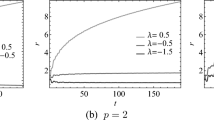Abstract
The equations of motion in the theory of general relativity obtained for the Schwarzschild metric yield an oscillatory differential equation with weak quadratic nonlinearity. This nonlinearity induces the well-known parametric expression for the relocation of the orbital periapsis, usually termed as periapsidal precession. It still represents a hard test for a gravitational theory viability. In the standard process of obtaining the precession, some approximation methods are employed, however it seems that the methods can provide better information then it is usually presented in the literature. We give an in-depth analysis of the oscillatory nonlinear differential equation as a dynamical system, also analyzing the conditions for obtaining the precession given other nonlinearities. Then, we outline a procedure for obtaining this precession for more general types of nonlinearities and the conditions which apply on them.





Similar content being viewed by others
References
Janssen, M., Norton, J.D., Renn, J., Sauer, T., Stachel, J.: Introduction to Volumes 1 and 2: The Zurich notebook and the genesis of general relativity. In: Janssen, M., Norton, J.D., Renn, J., Sauer, T., Stachel, J. (eds.) The genesis of general relativity, Boston studies in the philosophy of science, vol. 250. Springer, Dordrecht (2017)
Tolman, R.C.: Relativity, thermodynamics and cosmology. Clarendon Press, Oxford (1934)
Schiff, L.I.: On experimental tests of the general theory of relativity. Am. J. Phys. 28(4), 340–343 (1960)
Polyanin, D.A., Zaitsev, V.F.: Handbook of exact solutions for ordinary differential equations. Chapman & Hall/CRC, New York (2002)
Erklärung der Perihelbewegung des Merkur aus der allgemeinen Relativitätstheorie, Sitzungberichte der Königlich Preussichen Akademie der Wissenschaften, vol XLVII, no. 18 Nov., 1915, pp. 831–839
Moller, C.: The theory of relativity. Clarendon Press, Oxford (1955)
D’Inverno, R.: Introducing Einstein relativity. Clarendon Press, Oxford (1998)
Dean, B.: Phase-plane analysis of perihelion precession and Schwarzschild orbital dynamics. Am. J. Phys. 67(1), 78–86 (1999)
Author information
Authors and Affiliations
Corresponding author
Additional information
Publisher's Note
Springer Nature remains neutral with regard to jurisdictional claims in published maps and institutional affiliations.
Rights and permissions
About this article
Cite this article
Celakoska, E., Lazarevska, A.M. Conditions on nonlinearity of oscillatory equations inducing the periapsidal precession. Gen Relativ Gravit 51, 67 (2019). https://doi.org/10.1007/s10714-019-2550-1
Received:
Accepted:
Published:
DOI: https://doi.org/10.1007/s10714-019-2550-1




